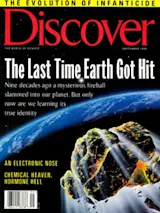While Saturn’s rings are obvious to anyone who picks up a telescope, few scientists even suspected Jupiter had a ring until images from the Voyager spacecraft in 1979 showed a faint, backlit arc on either side of the planet. Unlike Saturn’s rings, which are thin disks made of boulder-size chunks of frozen gas, Jupiter’s ring is thought to consist mostly of dust knocked off the tiny moons Metis and Adrastea by micrometeorites, and ash from volcanoes on the moon Io. Jupiter’s ring also has an odd shape that has puzzled astronomers: the inner edge is about 6,000 miles thick but tapers to a depth of just 200 miles at the outer edge. Two astrophysicists recently suggested an explanation for that distortion.
Mihály Horányi of the University of Colorado and his colleague Thomas Cravens of the University of Kansas have created a computer model in which Jupiter’s powerful magnetic field indirectly ...














